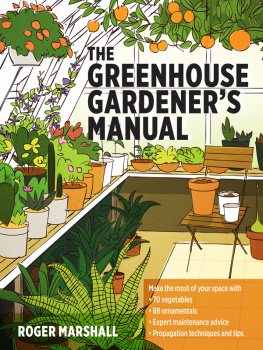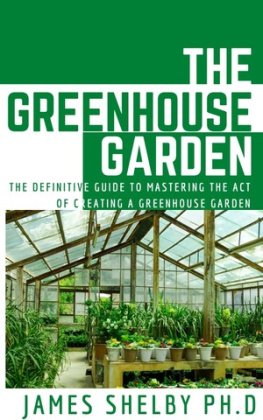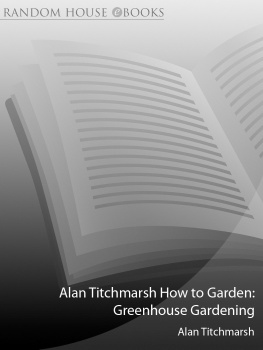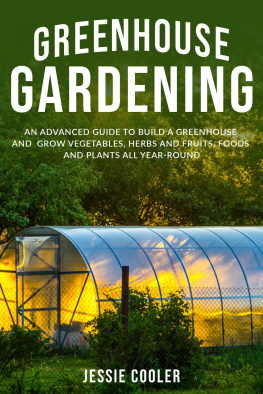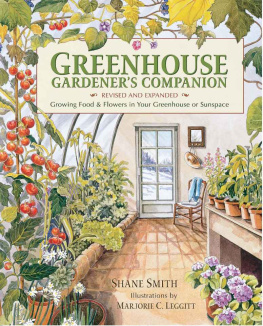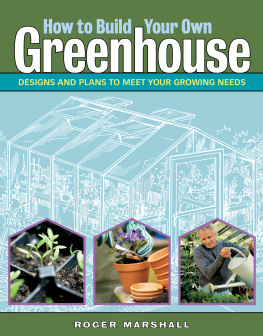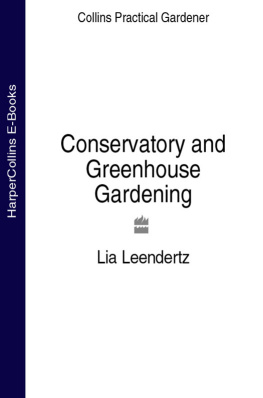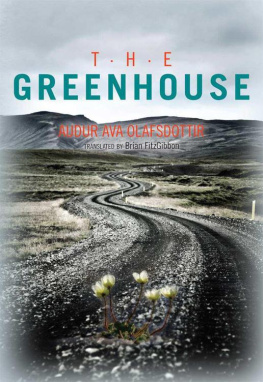Roger Marshall - The Greenhouse Gardener’s Manual
Here you can read online Roger Marshall - The Greenhouse Gardener’s Manual full text of the book (entire story) in english for free. Download pdf and epub, get meaning, cover and reviews about this ebook. year: 2014, publisher: Timber Press, genre: Science. Description of the work, (preface) as well as reviews are available. Best literature library LitArk.com created for fans of good reading and offers a wide selection of genres:
Romance novel
Science fiction
Adventure
Detective
Science
History
Home and family
Prose
Art
Politics
Computer
Non-fiction
Religion
Business
Children
Humor
Choose a favorite category and find really read worthwhile books. Enjoy immersion in the world of imagination, feel the emotions of the characters or learn something new for yourself, make an fascinating discovery.
- Book:The Greenhouse Gardener’s Manual
- Author:
- Publisher:Timber Press
- Genre:
- Year:2014
- Rating:4 / 5
- Favourites:Add to favourites
- Your mark:
- 80
- 1
- 2
- 3
- 4
- 5
The Greenhouse Gardener’s Manual: summary, description and annotation
We offer to read an annotation, description, summary or preface (depends on what the author of the book "The Greenhouse Gardener’s Manual" wrote himself). If you haven't found the necessary information about the book — write in the comments, we will try to find it.
The Greenhouse Gardener’s Manual — read online for free the complete book (whole text) full work
Below is the text of the book, divided by pages. System saving the place of the last page read, allows you to conveniently read the book "The Greenhouse Gardener’s Manual" online for free, without having to search again every time where you left off. Put a bookmark, and you can go to the page where you finished reading at any time.
Font size:
Interval:
Bookmark:
The Greenhouse Gardeners Manual
Roger Marshall
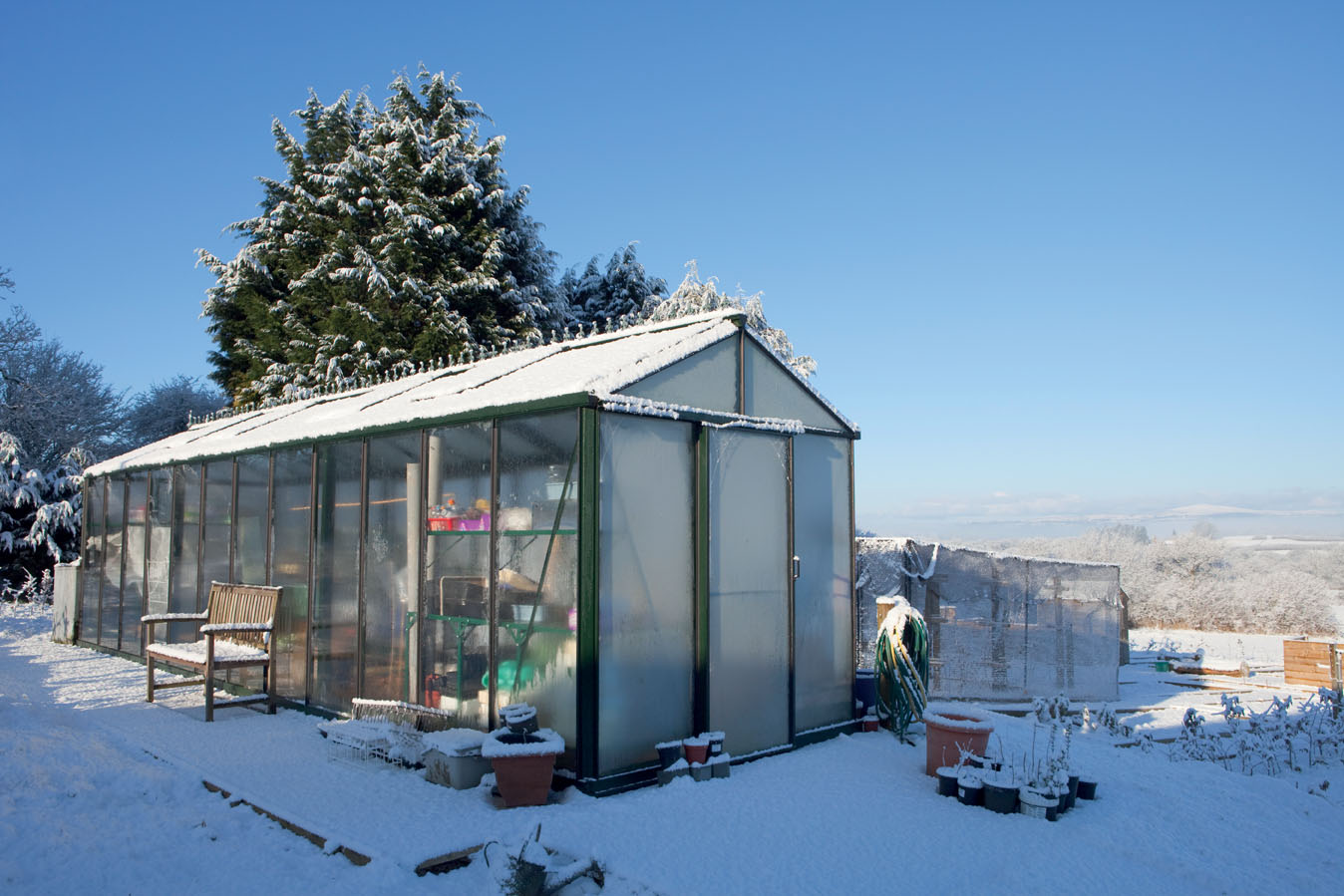
Timber Press
Portland London
Copyright 2014 by Roger Marshall. All rights reserved.
Published in 2014 by Timber Press, Inc.
Photo and illustration credits appear on .
The information in this book is true and complete to the best of our knowledge. All recommendations are made without guarantee on the part of the author or Timber Press. The author and publisher disclaim any liability in connection with the use of this information.
The Haseltine Building
133 S.W. Second Avenue, Suite 450
Portland, Oregon 97204-3527
timberpress.com
6a Lonsdale Road
London NW6 6RD
timberpress.co.uk
Cover and text design by Breanna Goodrow
Library of Congress Cataloging-in-Publication Data
Marshall, Roger, 1944
The greenhouse gardeners manual / Roger Marshall.1st ed.
p. cm.
Includes bibliographical references and index.
ISBN 978-1-60469-637-0
1. Greenhouse gardeningHandbooks, manuals, etc. I. Title.
SB415.M28 2014
635.9823--dc23
2013042333

It is early spring, and outdoors the trees are just starting to send out leaves. But in the greenhouse you bite into a fresh, juicy tomato that you have just plucked from a vine. Nearby, key limes and oranges await harvesting, their citrusy aroma wafting through the warm, humid air. Flowers, including fuchsias, orchids, and paperwhites, add their heady fragrance to the mix. These are just some of the pleasures of owning a home greenhouse.
And there is more than just the sheer joy of picking produce and flowers out of season that makes a home greenhouse so appealing. A greenhouse can be a warm, inviting place to put chairs or a hammock to relax in, or it can be an addition built onto your house that helps to provide home heating when the weather is frigid. One day after a winter snowstorm in Rhode Island, I brushed the snow off the greenhouse that is attached to my office. Once the sun hit the greenhouse glass, the temperature inside quickly reached 78F (25C). Just by opening the connecting office door, I was soon enjoying all that warmth and humidity without turning on a heater. I felt like I had been transported to Florida despite the snowy outdoor landscape.
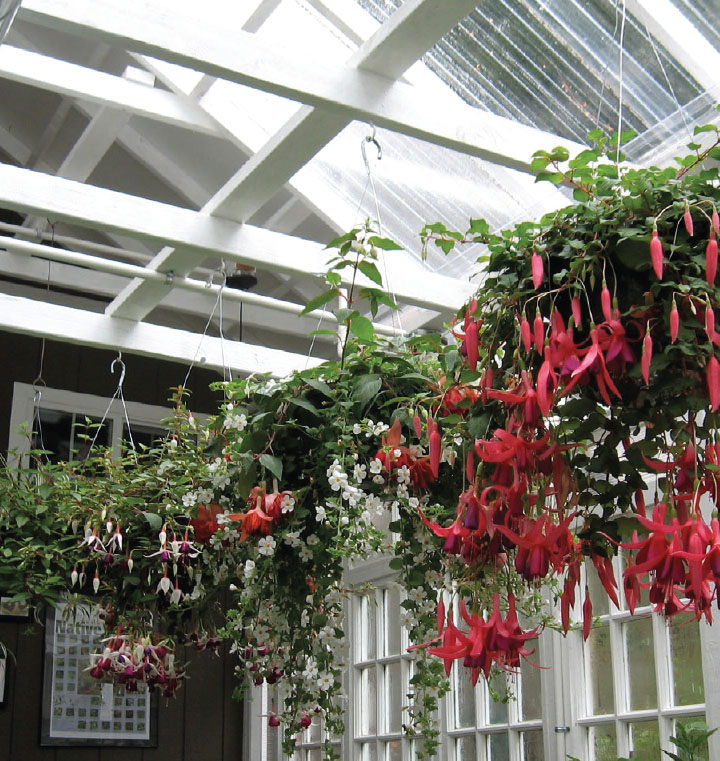
Baskets of fuchsias hanging from the rafters bring rich color to the home greenhouse.
Greenhouses can be used for other purposes as well. You can create a fish-tank system that circulates nutrient-rich water to irrigate an exotic mix of lush tropical plants or hydroponic strawberries. You can store tender plants over the winter months. You can even start a small business propagating and selling specialty plants. The possibilities are limited only by your imagination.
As soon as you buy or build a greenhouse you will probably want to know more about keeping your plants growing year-round. I would suggest you join the Hobby Greenhouse Association, whose members use the website and quarterly magazine to keep abreast of news and information in the home greenhouse world. Oh, and I edit the magazine, so I know that its full of inspiration and practical information, much like this book.
Roger Marshall
Jamestown, RI
ONE
CHOOSING THE RIGHT GREENHOUSE

A typical kit greenhouse has a conventional shape and an aluminum frame, and is glazed with polycarbonate panels.
P lants that are grown outdoors must be well suited to their environment. They thrive in response to the daily rise and fall of temperatures, the change of the seasons, and the amount of light available to them. But many gardeners long to grow plants that would not survive in the conditions found outdoors in their gardens. Thats why many choose to grow plants in a greenhouse.
When buying or building a greenhouse, your first basic choice is whether it should be freestanding or attached to your home, each of which has its advantages and drawbacks. The second choice is whether you intend to heat it through the winter months and, if so, how much you are willing to spend in order to do so. Knowing the temperature you need to maintain in your greenhouse over the winter months will help determine the style of greenhouse and many of its features. Temperature requirements in turn depend on what kind of plants you intend to grow. Do you want to grow cool-season edibles or heat-loving summer vegetables like tomatoes and peppers? Would you use the greenhouse for plant propagation and seed starting? Or would you like to grow specialty plants like orchids or bromeliads? All these options call for different heating and lighting needs.
In general, an unheated greenhouse lets you grow plants rated for about one USDA climate zone warmer than your local area. This translates to about five to eight degrees Fahrenheit (two to four degrees Celsius). Another way to think of it is that youll add two to three weeks on each end of the growing season. But if you provide supplemental heat and light in the greenhouse, you can grow any kind of plant you likeas long as you are willing to pay for it. An aluminum-frame, single-pane glass greenhouse used to house tropical orchids through a New England winter could easily cost hundreds of dollars a month to heat, whereas a simple unheated polytunnel could double your winter vegetable production.
Greenhouse Shapes and Sizes
The shape of a greenhouse determines the amount of light that reaches plants and also affects its heat efficiency. The majority of kit greenhouses have a very simple design, with four sides and a peaked roof, a conventional freestanding shape that is optimum for ease of shipping and construction, but not as efficient for heating a space in which to grow plants. The amount and type of glazingwhether glass, polycarbonate, fiberglass, or polyethylene filmvaries between models. Here are the most common types of greenhouse shapes, both freestanding and attached.
CONVENTIONAL
The most common style of greenhouse, including most prefabricated kits. Has vertical sides and a roof that slopes up toward a central ridge. Can be framed with wood, steel, or aluminum, and glazed with glass or any kind of polycarbonate, acrylic, or fiberglass. Best orientation for maximum light penetration: axis east-west.
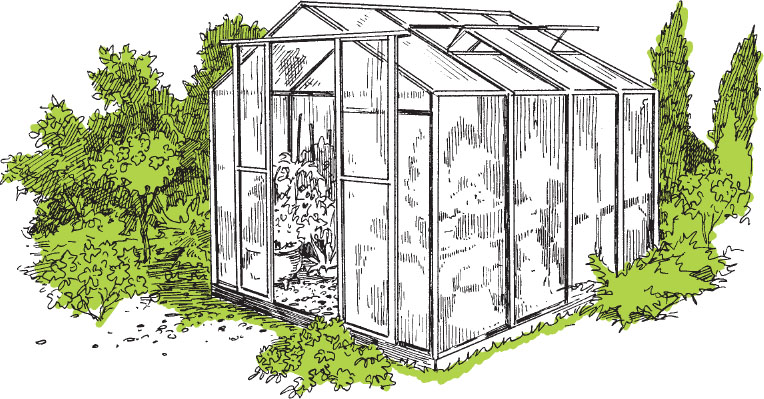
GOTHIC ARCH
The sides curve toward a central ridge, which prevents the roof from sagging under a snow load. Can be constructed from scratch or purchased from a supplier. Framed with wood, steel or aluminum; only suitable for flexible polycarbonate or fiberglass glazing due to the curved sides. Best orientation for maximum light penetration: axis east-west.
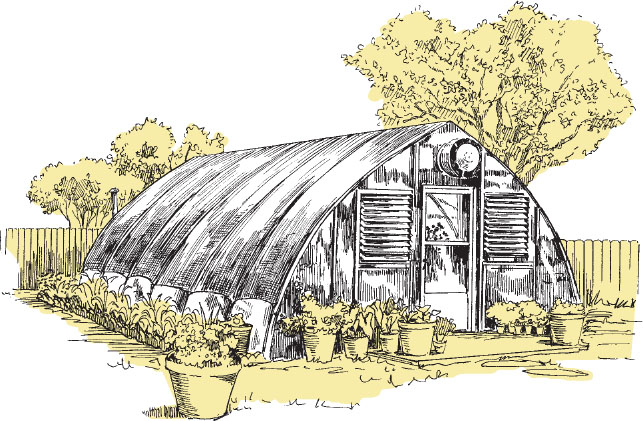
HOOP HOUSE
Also known as Quonset or high-tunnel greenhouses, hoop houses have a frame of curved steel hoops and are covered with greenhouse-grade polyethylene film. A double layer of film with warm air blown between the layers forms a more effective heat barrier than a single wall. These greenhouses can withstand snow and wind, but they must be properly anchored down. On hot, sunny days, any greenhouse can heat up quickly and overheat plants, hoop houses without ventilation in particular. Best orientation for maximum light penetration: axis east-west.
Next pageFont size:
Interval:
Bookmark:
Similar books «The Greenhouse Gardener’s Manual»
Look at similar books to The Greenhouse Gardener’s Manual. We have selected literature similar in name and meaning in the hope of providing readers with more options to find new, interesting, not yet read works.
Discussion, reviews of the book The Greenhouse Gardener’s Manual and just readers' own opinions. Leave your comments, write what you think about the work, its meaning or the main characters. Specify what exactly you liked and what you didn't like, and why you think so.

